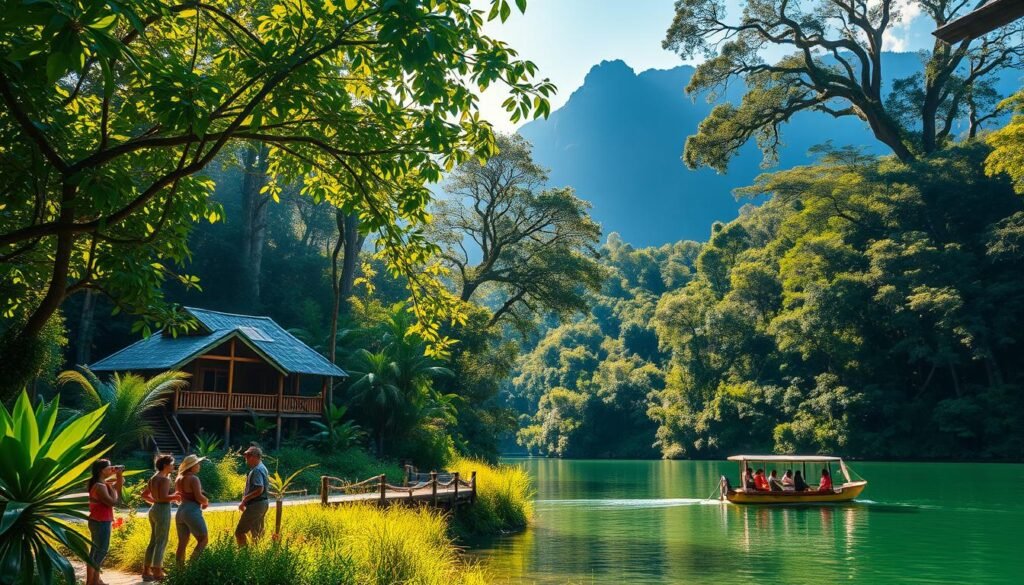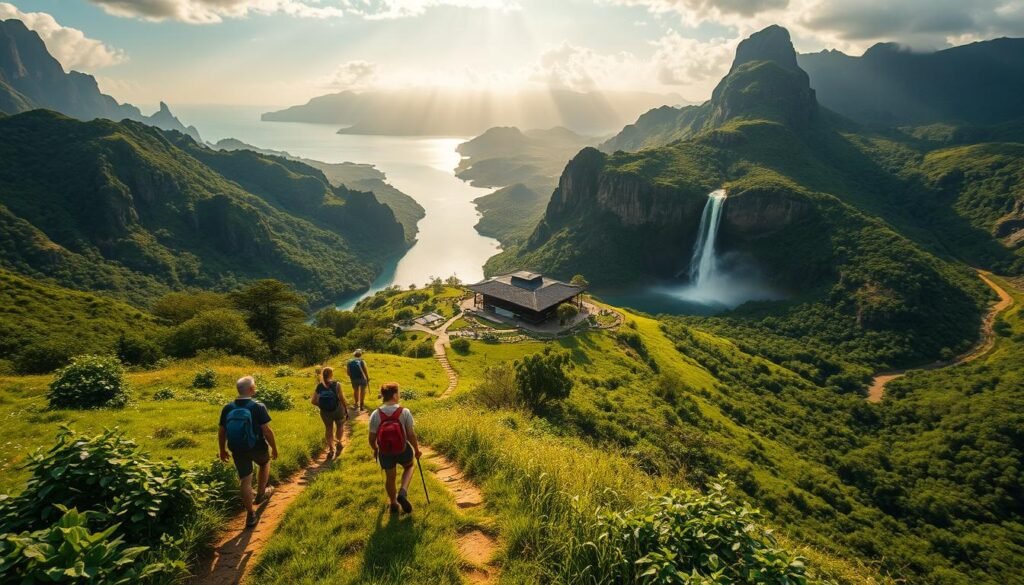Best Ecotourism Destinations
As we travel, we’re learning more about how our trips affect the Earth. Ecotourism lets us see the world’s wonders while helping protect nature and supporting local people.
Sustainable travel locations are becoming more popular. This is because they focus on saving the environment. By visiting these places, we can see different cultures and stunning views while helping the planet.
Ecotourism is more than just seeing beautiful spots. It’s about connecting with nature and helping the people who live there.
Key Takeaways
- Explore nature while supporting conservation efforts
- Experience unique cultures and landscapes
- Promote environmental protection through sustainable travel
- Support local communities and their conservation initiatives
- Immerse yourself in the natural beauty of our planet
Understanding Ecotourism and Its Importance
Ecotourism has become more popular, showing us how to travel better. It helps us see the world in a way that’s good for the planet. This is key for those who want to travel responsibly.
What is Ecotourism?
Ecotourism means traveling to nature spots and helping the environment. It’s about enjoying nature while keeping it safe for others. It’s all about making choices that don’t harm the planet.
Ecotourism is not just about visiting eco-friendly vacation spots; it’s a way of traveling that supports conservation efforts and promotes cultural understanding.
Benefits of Ecotourism
Ecotourism has many good sides. It helps local communities by giving them jobs and money. It also helps keep nature safe for all of us.
“Ecotourism has the power to help nature and support local people, making it good for everyone.”
| Benefits | Description |
|---|---|
| Economic Benefits | Supports local economies through job creation and infrastructure development. |
| Conservation | Promotes the preservation of natural habitats and biodiversity. |
| Cultural Exchange | Fosters cultural understanding and exchange between travelers and local communities. |
How Ecotourism Supports Conservation
Ecotourism helps protect nature. It supports places that care for the environment. It also teaches people why nature is important.
Exploring ecotourism is important. It shows us how to travel in a way that’s good for the planet. By choosing places that care for nature, we help make the world a better place.
Best Ecotourism Destinations in the United States
Ecotourism in the United States covers many places, from rainforests to vast wilderness. The U.S. has many spots for ecotourism. But, countries like Costa Rica and Alaska are known for their beauty and conservation.
Best Ecotourism Destinations in Costa Rica
Costa Rica is a top spot for ecotourism. It has 30 national parks, 19 wildlife refuges, and 8 biological reserves. This country is known for its green tourism and conservation.
Visitors can hike in cloud forests or enjoy Pacific coast beaches. Costa Rica offers many green travel experiences.
Alaska’s Untamed Wilderness
Alaska is known for its vast, untouched landscapes. It’s perfect for nature immersion activities like wildlife watching, hiking, and kayaking. Places like Denali National Park and Preserve show Alaska’s stunning beauty.
Costa Rica and Alaska are great examples of ecotourism. They offer unique green travel experiences that support conservation.
Exploring National Parks for Ecotourism
The U.S. national parks are full of diverse ecosystems and geological wonders. They offer great chances for environmentally conscious travel and help with conservation.
Places like Yellowstone and Yosemite are top spots for eco-tourism in the U.S. They draw visitors worldwide with their natural beauty and outdoor fun.
Yellowstone National Park
Yellowstone, America’s first national park, is famous for its geothermal sights like Old Faithful. It’s also a home to many animals, including grizzly bears, wolves, and bison.
Yellowstone is perfect for hiking, camping, and watching wildlife. You can see the Grand Prismatic Spring and Mammoth Hot Springs on its trails.
| Ecotourism Activity | Location | Description |
|---|---|---|
| Hiking | Grand Prismatic Spring Trail | A 3-mile hike with stunning views of the spring |
| Wildlife Watching | Lamar Valley | Great for spotting grizzly bears and wolves |
| Camping | Grant Village Campground | Campsites with beautiful views of the landscape |
Yosemite National Park
Yosemite is a famous spot for ecotourism, known for its cliffs, waterfalls, and giant sequoias. It has many outdoor activities like hiking, rock climbing, and snowshoeing.
Yosemite’s trails, like the Mist Trail and Four Mile Trail, show off the park’s beauty. It’s also a place where you can see black bears, mule deer, and peregrine falcons.
Visiting these national parks helps conservation and supports sustainable tourism. Whether you love hiking, wildlife watching, or just enjoying the views, Yellowstone and Yosemite are great for ecotourists.
Unique Ecotourism Experiences Around the World
The world is full of amazing places to explore. From lush rainforests to vast deserts, there’s something for everyone. These places are not just beautiful but also focus on protecting nature.
Galapagos Islands: A Natural Wonder
The Galapagos Islands are a special place, known for their unique wildlife. This group of islands is home to animals you can’t find anywhere else. It’s a dream spot for those who love nature and science.
Key Attractions: See the islands’ volcanic landscapes, swim with sea turtles, and watch marine iguanas and blue-footed boobies.
Patagonia: Adventure Awaits
Patagonia is at the southern tip of South America, shared by Argentina and Chile. It’s known for its stunning mountains, glaciers, and valleys. It’s perfect for those who love the outdoors, with activities like hiking and kayaking.
Sustainable Tourism Practices: There are eco-friendly tours and activities. These help local conservation and communities.
| Destination | Main Attractions | Sustainable Practices |
|---|---|---|
| Galapagos Islands | Wildlife observation, snorkeling, volcanic landscapes | Eco-friendly tours, conservation efforts |
| Patagonia | Hiking, kayaking, mountaineering, glaciers | Support for local communities, eco-friendly accommodations |
The Galapagos Islands and Patagonia are great for those who love adventure. They also teach us about protecting our planet. By choosing eco-friendly travel, we help keep these amazing places safe for future generations.
How to Choose the Right Ecotourism Destination
Finding the perfect ecotourism spot can seem hard. But knowing what to look for makes it easier. With more people caring about the environment, eco-friendly vacation spots are in high demand.
Think about places that are not just beautiful but also follow responsible tourism practices. Look for places that help local communities and don’t harm the environment.
Considerations for Selecting Destinations
There are several things to think about when picking an ecotourism spot. These include:
- The destination’s commitment to conservation efforts
- The presence of eco-friendly infrastructure
- Opportunities for engaging with local communities
- The overall environmental impact of tourism activities
Let’s dive deeper into these points:
| Destination | Conservation Efforts | Eco-Friendly Infrastructure |
|---|---|---|
| Costa Rica | Protected areas and wildlife conservation | Renewable energy sources and sustainable buildings |
| New Zealand | National parks and conservation programs | Eco-lodges and environmentally friendly accommodations |
Eco-Friendly Accommodations
Choosing the right place to stay is key in ecotourism. Look for places made from recycled materials and run on renewable energy sources. They help reduce harm to the environment and make your trip better.
When picking your stay, search for signs of sustainability. This means energy-saving gadgets, less waste, and materials that are good for the planet.
By paying attention to these details, you help protect our world. And you get to enjoy amazing and meaningful experiences.
Sustainable Practices to Look For
Ecotourism is all about green travel experiences that protect wildlife and local communities. As people become more aware of their impact, they seek sustainable tourism practices more than ever.
Wildlife Protection and Preservation
Wildlife protection and preservation are key in sustainable ecotourism. It means supporting conservation efforts and keeping natural habitats safe. Many top nature immersion getaways work hard to protect local wildlife by:
- Creating protected areas and sanctuaries
- Implementing anti-poaching laws and enforcement
- Supporting research and conservation projects
| Conservation Effort | Description | Impact |
|---|---|---|
| Protected Areas | Designated zones for wildlife protection | Preserves biodiversity |
| Anti-Poaching Laws | Laws and enforcement to prevent wildlife poaching | Reduces threat to endangered species |
| Research Projects | Studies on wildlife behavior and habitat | Informs conservation strategies |
Local Community Engagement
Local community engagement is also essential in sustainable ecotourism. By supporting local economies and respecting cultural heritage, travelers help the communities they visit. This includes:
- Community-based tourism initiatives
- Supporting local businesses and artisans
- Participating in cultural exchange programs

By picking destinations that focus on sustainable practices, travelers can have amazing top nature immersion getaways. They also help keep our planet’s beauty and cultural diversity alive.
Activities That Promote Ecotourism
Ecotourism lets travelers dive into nature with little harm to the environment. It’s about enjoying the outdoors and helping nature at the same time. This way, we can connect more with the world around us and help protect it.
Hiking and Nature Walks
Hiking and nature walks are top choices for ecotourism. They let people see different landscapes and learn about nature. These activities are good for our bodies and minds, and they teach us to love nature.
Guided nature walks give us a closer look at plants and animals. Eco-lodges and nature spots often have guided hikes. This way, we can enjoy the beauty of nature and help local businesses.
Kayaking and Water Sports
Kayaking and water sports give a special view of nature. They let us see rivers, lakes, and coasts up close. These activities make us feel adventurous and connected to the water world.
“The quieter you are, the more you can hear.” This quote shows what kayaking is like. It lets us see animals in their natural home.
Many places for ecotourism have kayaking tours and water sports. They teach us about nature and how to protect it. By joining these activities, we help keep water clean and support local people.
As ecotourism gets more popular, we need to be careful. We should choose tours that are good for the planet. By doing this, we help keep nature safe for others in the future.
Ecotourism’s Role in Climate Action
Ecotourism plays a big role in fighting climate change. It helps cut down on carbon emissions and supports green energy. It’s a better choice than regular tourism because it focuses on being green and saving nature.
Minimizing Environmental Impact
Ecotourism helps reduce our carbon footprint in many ways. For example, picking places closer to home cuts down on flights. Or, using electric or hybrid cars is another good choice.
Eco-friendly hotels are also key. They use green energy, collect rainwater, and reduce waste. This helps protect our planet.
Promoting Sustainable Energy
Ecotourism also supports green energy. Places are starting to use solar or wind power instead of fossil fuels. This is good for the environment.
Travelers can help by picking tours that use green energy. This not only cuts down on carbon emissions but also helps build green places for tourists.

Places like Costa Rica and Alaska are great examples. They have eco-lodges and tours that use green energy. These places show how ecotourism can help both the environment and local people.
By choosing eco-friendly travel, we can help fight climate change. As more people want to travel green, ecotourism’s effect on the environment will grow.
Planning Your Ecotourism Adventure
Planning an ecotourism trip is more than picking a place. It’s about sustainable travel practices. With more people caring about the environment, eco-friendly vacation spots are in high demand.
Essential Tips for First-Time Travelers
For those new to ecotourism, there are important things to keep in mind. First, do your research. Learn about the local culture, environment, and rules of your destination. This knowledge can make your trip better.
“The journey of a thousand miles begins with a single step,” as Lao Tzu once said, stressing the need for preparation.
- Look for places known for their conservation work.
- Plan your trip to reduce your carbon footprint.
- Interact with local communities to support their economy.
Packing Essentials for Eco-Friendly Travel
It’s important to pack the right things for an eco-friendly trip. Use reusable items like water bottles, cloth bags, and eco-friendly toiletries.
For clothes, pick items made from sustainable materials. Also, pack layers for different weather. “Sustainable travel is not just about the places you visit, but also about how you travel,” says an ecotourism expert.
- Bring a refillable water bottle to cut down on plastic waste.
- Choose clothes made from recycled or organic materials.
- Use eco-friendly sunscreen to protect marine life.
By following these tips, travelers can help preserve sustainable travel locations. They can also have a deeper connection with nature.
Future Trends in Ecotourism
The ecotourism industry is changing fast. More people want to travel responsibly and enjoy green experiences. To meet this demand, the industry is introducing new ideas and practices.
New Horizons
New places are becoming popular for eco-friendly travel. Countries like Bhutan and Rwanda are leading the way. They offer amazing experiences that also help local communities.
Technological Advancements
Technology is making ecotourism better and more sustainable. It helps find eco-friendly places to stay and promotes responsible travel. By using these new tools, travelers can have a positive impact on the environment.

















Leave a Reply